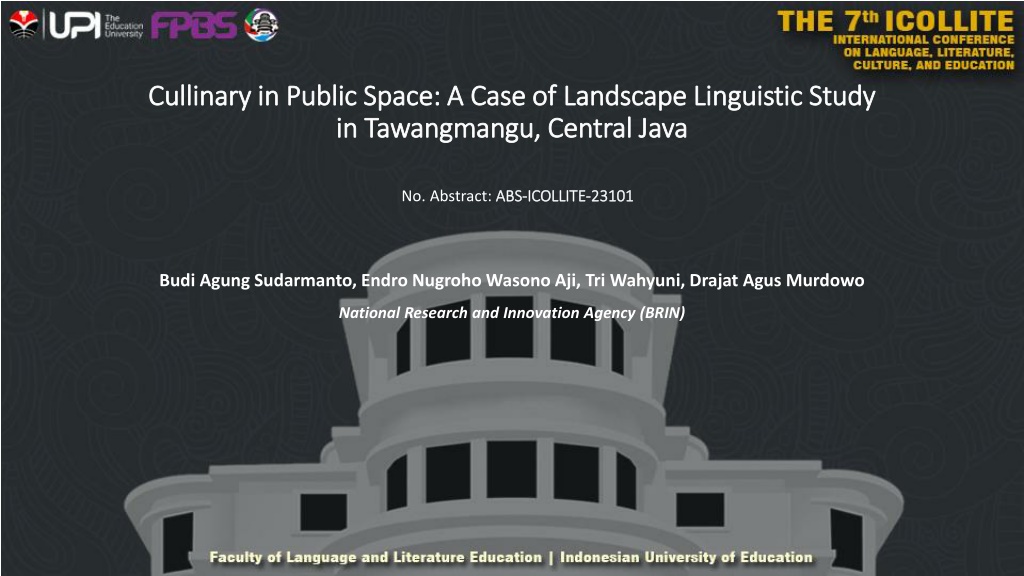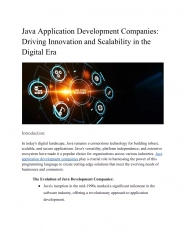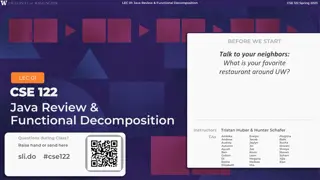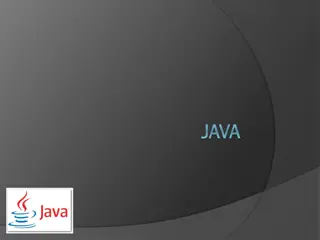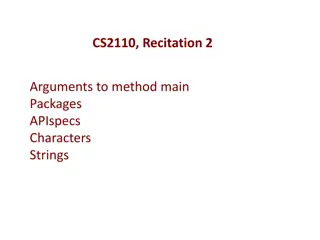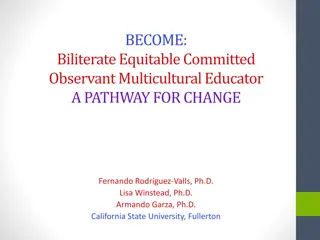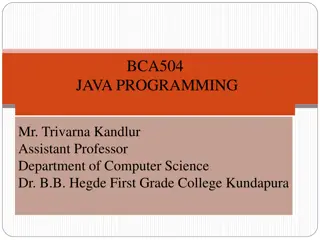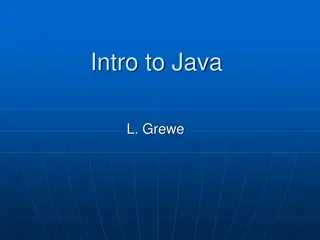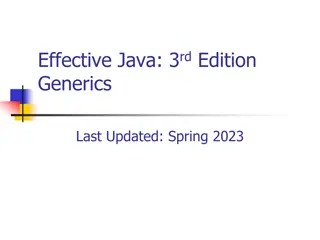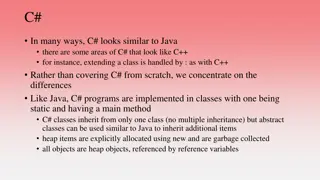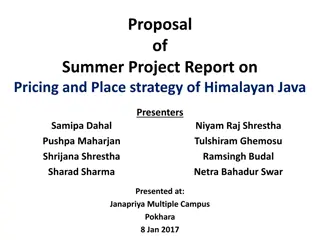Cultural and Culinary Landscape in Tawangmangu, Central Java: A Linguistic Study
Exploring the culinary and cultural landscape of Tawangmangu, Central Java through a landscape linguistic study, revealing the unique multilingual and multicultural aspects of the region. The research delves into the coexistence of diverse languages and culinary traditions, highlighting the significance of culinary practices in shaping the identity and promoting tourism in Tawangmangu.
Download Presentation

Please find below an Image/Link to download the presentation.
The content on the website is provided AS IS for your information and personal use only. It may not be sold, licensed, or shared on other websites without obtaining consent from the author. Download presentation by click this link. If you encounter any issues during the download, it is possible that the publisher has removed the file from their server.
E N D
Presentation Transcript
Cullinary in Public Space: A Case of Landscape Linguistic Study Cullinary in Public Space: A Case of Landscape Linguistic Study in Tawangmangu, Central Java in Tawangmangu, Central Java No. Abstract: ABS ABS- -ICOLLITE ICOLLITE- -23101 23101 Budi Agung Sudarmanto, Endro Nugroho Wasono Aji, Tri Wahyuni, Drajat Agus Murdowo National Research and Innovation Agency (BRIN)
INTRODUCTION Tawangmangu as one of district in Karanganyar Regency, Central Java Province as a tourism destination complexity multiculture, multilanguage Landscape Linguistics Cullinary Gastronomy Previous Study Cullinary in Landscape Linguistics (?)
LITERATURE REVIEW Landscape Linguistics Landry & Bourhis (1997) Gorter (2018) Backhaus (2006) Ben-Rafael (2009) Cullinary Descartes: Cogito Ergo Sum; Woodward: Edo ergo sum - I eat, therefore I am Jean Anthelme Brillat-Savarin, Tell me what you eat, I ll tell you who you are (Utami, 2018). Gastronomy Hjalanger & G. Richards, (2002) culinary tourism, also referred to as gastronomic . Freeman (2010) Gastronomy Indonesia
METHOD Research Design: Qualitative Research Analyzing form and function LL signs Shohamy (2006): LL tends to give attention to the certain languages, apperance order, form, and function Location: Tawangmangu, Karanganyar, Central Java Kind and Source of Data Backhaus (2006): any piece of written text within a spatially definable frame. Data Collection: observation and documentation Data Analysis: descriptive interpretative
FINDING AND DISCUSSION AND DISCUSSION Data found: 430 photographs Name of Languages Mad Jap 1 11 Cul Ind Ing Ara Jav 117 Chi Lat San Sun 2 Gre Tur Spa 410 95,34 Quantity % 193 44,88 11,39 27,21 0,23 2,56 49 3 2 1 3 1 2 101 0,7 0,46 0,46 0,23 0,7 0,23 0,46 23,5 Cullinary: Local: Cothot, rabbit satay Indonesian: soup, value fish, fried/grilled chicken Javanese: tengkleng, tongseng, satay, meatball, pentol Chinese: kweatiaw, capcay Japanese: tiramisu Turkey: Kebab International: burger
FINDING AND DISCUSSION Public space of cullinary as landscpae linguistic space Multiculturalism in cullinary Preserving local cullinary Javanese cullinary Javanese community Cullinary support tourism in Tawangmangu
CONCLUSION Public signs of cullinary as landscape linguistic case Cullinary as a representation of Cullinary to support gastronomy in tourism
REFERENCES Woodward, K. (1999). Identity and Difference. London: Sage Publication. M. Hjalager and G. Richards. (2002). Gastronomy: an Essential Ingredient in Tourism Production and Consumption. Tour. Gastron. Freeman, N. (2010). Ethnic cuisine: Indonesia. http://www.sallybernstein.com/food/cuisines/indonesia/ Backhaus, P. (2006) Multilingualism in Tokyo: A Look into the Linguistic Landscape, International Journal of Multilingualism, 3:1, 52-66. DOI: https://doi.org/10.1080/14790710608668385. Ben-Rafael, E. (2009). A Sociological Approach to the Study of Linguistic Landscapes. Dalam: Shohamy, E & Gorter, D. (Editors). Linguistic Landscape: Expanding the Scenery. New York: Routledge. Pp 40-54. Gorter, D. (2018). Methods and Techniques for Linguistic Landscape Research: About Definitions, Core Issues And Technological Innovations. Dalam: Martin P tz &Neele Mundt (eds). Expanding the Linguistic Landscape: Multilingualism, Language Policy, and the Use of Space as a Semiotic Resource. Bristol: Multilingual Matters. Pp. 38-57. Landry, R., & Bourhis, R. Y. (1997). Linguistic Landscape and Ethnolinguistic Vitality: An Empirical Study. Journal of Language and Social Psychology, 16(1), 23 49. DOI: https://doi.org/10.1177/0261927X970161002. Onofri, L; Nunes, P. A.L.D.; Cenoz. J. & Gorter, D. (2013). Linguistic Diversity and Preferences: Econometric Evidence from European Cities. Journal of Economics and Econometrics. Vol. 56, No. 1, 2013 pp. 39-60. https://ideas.repec.org/a/eei/journl/v56y2013i1p39-60.html. Shohamy, E. (2006). Language Policy: Hidden Agendas and New Approaches. New York: Routledge. Utami, S. (2018). Kuliner sebagai Identitas Budaya: Perspektif Komunikasi Lintas Budaya. CoverAge, Vol. 8, No. 2, 36-44.
THANK YOU! Follow us @...
